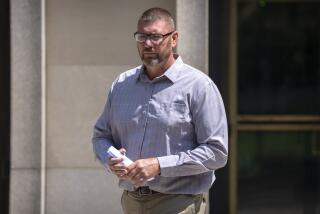Truck Driver in Capitol Crash Had History of Mental Illness, Violence
- Share via
SACRAMENTO — The man authorities believe smashed a loaded tractor-trailer into the state Capitol on Tuesday, incinerating himself in a ball of fire, had a 15-year history of criminal violence and bouts of mental illness.
Since 1986, Mike Bowers, 37, of Hemet had been in and out of prison for battery on a peace officer, child beating and assault with a deadly weapon.
In 1999, psychiatrists at Patton State Hospital asked authorities to keep Bowers in custody. The Riverside district attorney’s office agreed to petition the court, believing Bowers to be dangerous.
But he was released that year after a jury found otherwise.
Eight days ago, he passed a background check and was hired as a driver for Dick Simon Trucking Inc. of Salt Lake City. Some days later he picked up a load of Gold Cross Evaporated Milk from a Nestle factory in Modesto.
“It was very unfortunate and extremely embarrassing,” said trucking company President Kelle Simon. “I don’t understand how the driver can have a criminal history if it didn’t show up on the background check.”
Shortly before 9:30 Tuesday night, blaring his horn and driving at what police estimated was 50 mph, he drove the 18-wheel semi-truck laden with canned milk up the steps into the south entrance of the 127-year-old Capitol.
The man believed to be Bowers died in the resulting fire, which chased hundreds of legislators and staff members from the building. The charred remains of the driver were removed from the truck cab Wednesday, and authorities were awaiting dental and DNA checks before officially confirming his identity.
Searching for evidence to explain the crash, investigators came across a 1999 letter from Bowers to Gov. Gray Davis, sources in the Capitol said Wednesday. In the letter, described as “unthreatening in tone,” Bowers reportedly complained about being held in Patton State Hospital. Bowers, a source said, wrote Davis that he had come up with a secret explanation for the fall of the former Soviet Union.
The crash was the most serious at the Capitol since a 1984 firebombing that ignited a blaze in the old governor’s office, now part of the Capitol museum.
Assemblywoman Helen Thomson (D-Davis) said the suicide crash, which came a week after a shooting rampage in the Sierra foothills by a former mental patient that left three dead, is a wake-up call for reform of the state’s rules on mental health commitment.
Other legislators said the incident proves the need to revive a 1998 plan by former Gov. Pete Wilson to build a fence around the mostly unprotected Capitol.
During the last lawmaking session, Thomson unsuccessfully promoted legislation to reform the 30-year-old Lanterman-Petris-Short Act, which makes involuntary commitment difficult, even in extreme cases.
“What is so sad is that I get letters telling stories like this every day,” Thomson said. “Now it is on the front door of the Capitol, very graphically and very tragically.”
On the security front, even Sen. Deborah Ortiz (D-Sacramento), who led opposition to Wilson’s proposed fence, said something may be needed to fortify the building’s unprotected flanks.
“I’ve not concluded that we need a fence . . . but it is time to look at it anew,” Ortiz said.
The Capitol remained a surreal scene Wednesday.
Men in white lab coats surveyed the damage to the Senate side of the building, particularly the historic displays on the first floor, and the entrance, which suffered the heaviest damage.
Janitors scrubbed the sullied walls and tile floors, stained by smoke and water. Large fans and oversized hoses were placed throughout the building to remove the odor of chemicals and smoke. The doors and windows of lawmakers’ offices were wide open for ventilation.
Outside, the charred skeleton of the 18-wheeler still straddled the granite steps, surrounded by a hurriedly erected chain-link fence. Spectators lined up to view the wreckage and the blackened facade of the Capitol as crews from the U.S. Bureau of Alcohol, Tobacco and Firearms continued to search for evidence.
Bowers’ 15-year stint in and out of prison and mental hospitals began when he was convicted in Mono County in September 1986 of battery on a police officer, and sentenced to two years in prison.
Between 1987 and 1991 he was paroled four times and returned to prison four times, said Terry Thornton, spokeswoman for the California Department of Corrections. During that time, his offenses included battery, assault with a deadly weapon, child battery and resisting arrest.
In September 1991, Bowers violated felony probation related to his conviction in a 1989 incident in Riverside County in which he was charged with injuring a child and resisting law enforcement officers, authorities said.
Bowers’ then-girlfriend had called police saying that he was using physical force on her and their daughter, said Valerie Mraz, supervising deputy district attorney for Riverside County. Bowers had refused to let police in, barricading himself in his garage and later in the house.
Police eventually forced the door open and took Bowers into custody, Mraz said. In prison, he was diagnosed as having a mental disease or defect. In July 1995, he was paroled and sent to Atascadero State Hospital.
Three years later, state officials asked the Riverside County district attorney’s office to extend Bowers’ commitment another year. A jury trial was held on the issue, Bowers’ term was extended, and he was sent to Patton State Hospital.
In 1999, another trial was held after state officials sought a second one-year extension. The jury determined that he was no longer a threat to himself or others, and he was discharged in November.
“He has a mental disease or defect that we didn’t believe was in remission or would remain in remission absent treatment,” Mraz said Wednesday.
It was not the last encounter that Mraz’s office would have with Bowers. He was arrested last December in the Lake Elsinore area and charged with a misdemeanor count of domestic violence for allegedly assaulting his spouse.
Bowers, who represented himself in the case, was placed on probation. A number of conditions were imposed on him--including attendance at anger management classes, Mraz said.
“Mr. Bowers was articulate and appeared to have some knowledge of the law,” Mraz said. “There was no real outward manifestations of any grave mental illness.”
*
Times staff writers Miguel Bustillo, Jenifer Warren, Dan Morain and George Ramos contributed to this report.
More to Read
Sign up for Essential California
The most important California stories and recommendations in your inbox every morning.
You may occasionally receive promotional content from the Los Angeles Times.










